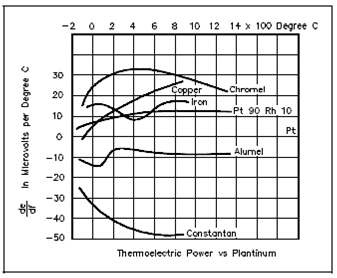Thermocouple Construction:
A thermocouple is constructed of two dissimilar metal wires joined at one end. While one end of each wire is linked to a measuring instrument, a thermocouple becomes a sensitive and highly accurate measuring device. Thermocouples might be constructed of various different combinations of materials. A performance of a thermocouple material is commonly determined through using that material along with platinum. The extremely important factor to be considered while selecting a pair of materials is the "thermoelectric difference" among the two materials. A significant difference among the two materials will result in better thermocouple performance. Above Figure describes the features of the more generally used materials while used with platinum.

Figure: Thermocouple Material Characteristics When Used with Platinum
Other materials might be used in further to that display in Figure. For instance: Chromel- Constantan is excellent for temperatures up to 2000°F; Nickel/Nickel-Molybdenum sometimes exchanges Chromel-Alumel; and Tungsten-Rhenium is used for temperatures up to 5000°F. Some combinations used for specialized applications are Molybdenum-Tungsten, Chromel-White Gold, Iridium/Iridium-Rhodium, and Tungsten-Iridium.
Figure display the internal construction of a classical thermocouple. The direct of the thermocouple are encased in a rigid metal sheath. A measuring junction is normally formed at the bottom of the thermocouple housing. Surround the thermocouple Magnesium oxide wires to prevent vibration that could damage the fine wires and to enhance heat transfer between the measuring junction and the medium surrounding the thermocouple.